Physical Address
304 North Cardinal St.
Dorchester Center, MA 02124
The frequency of diagnosis and treatment of ankyloglossia (tongue tie) and tight maxillary frenulum (lip tie) has increased dramatically in the last few decades.
Ankyloglossia can be categorized into four types, with types I and II describing “anterior” ankyloglossia and types III and IV “posterior” ankyloglossia.
Evidence supports lingual frenotomy in the neonatal period for infants with evidence of latching problems caused by ankyloglossia.
A decrease in the mother’s nipple pain is the most common beneficial outcome after lingual frenotomy for neonatal tongue tie. Frenotomy/frenuloplasty is a safe procedure in children of all ages.
Frenotomy in the newborn is best performed without general anesthesia in most infants. Oral sucrose (24%) is effective for reducing procedural pain in neonates. Topical or injected lidocaine/benzocaine should not be used.
Ankyloglossia has been associated with articulation disorders in children and adults, although supporting evidence is limited. Ankyloglossia has also been associated with mechanical social issues such as difficulty licking the lips, maintaining dental hygiene, playing a wind instrument, diastasis between the lower central incisors, and “French” kissing.
The maxillary (upper labial) frenulum is a normal structure of uncertain significance.
It has been proposed that a tight maxillary frenulum (lip tie) may cause an infant to have a poor latch onto the breast. However, evidence is limited.
A tight maxillary frenulum may contribute to difficulty cleaning the teeth and may contribute to a diastasis between the upper central maxillary incisors.
Maxillary frenulectomy has been proposed to facilitate breastfeeding, but evidence is lacking.
Maxillary frenulectomy may facilitate orthodontic treatment in some patients.
Ankyloglossia, commonly called tongue tie, is a congenital anomaly characterized by an abnormally short lingual frenulum, which may restrict the mobility of the tongue tip. The clinical significance and optimal management of this anomaly have been the subject of debate for centuries. As one author from the mid-20th century aptly commented, “much entertaining nonsense has been written about tongue-tie,” and similarly more recent authors have published papers with pointed titles such as “Much Ado About Nothing: Two Millennia of Controversy on Tongue-Tie,” and “Tongue-Tie: The Disease Du Jour.”
Opinions about the relationship between ankyloglossia and its consequences vary greatly in various regions of the world and between professions. In a recent study, professionals from Western countries (83%) were more likely than those from Asian countries (52%) to believe in a relationship between tongue tie and breastfeeding difficulties. Survey studies show that nurses and allied health professionals are more likely than doctors or dentists to strongly agree that feeding difficulties are caused by ankyloglossia. ,
Unquestionably, infants are increasingly being diagnosed and treated for ankyloglossia in selected wealthy countries. In a review of multiple U.S. inpatient databases from 1997 to 2012, the number of children diagnosed with ankyloglossia increased nearly 10-fold, from 3934 to 32,837. In Australia, the Medicare frenotomy rate in 0- to 4-year-old children increased from 1.22 per 1000 population in 2006 to 6.35 per 1000 in 2016. Not surprisingly, as interest in ankyloglossia has increased, the number of publications on this subject in the medical literature has also increased dramatically.
It is hypothesized that the advent of the Internet and social media has contributed to the increase in diagnosis of ankyloglossia and frenotomy. A recent review via Google Trends showed the monthly number of searches for ankyloglossia to have tripled from January 2011 to January 2018; the number of searches for “lip tie” increased sevenfold over this same period. Social media sites aimed at parents who are focused on tongue tie and lip tie have become increasingly common.
Historical references to tongue tie may be found in ancient texts. The Greeks recognized the importance of the tongue; in the third century BCE, Aristotle stated “those whose tongues are slightly tied: their speech is indistinct and lisping, which is due to the fact that they cannot produce all sounds.” In the Middle Ages, it was common for midwives to divide the frenulum of the newborn using their fingernails. Surgeons, who evolved from barbers, were also known to lyse the frenulum, and a competition arose between surgeons, who were allowed to use instruments, and the midwives ( Fig. 33.1 ). As one neonatal historian recently wrote: “Like salting the infant’s lips, piercing the ears, forming and deforming the skull, tight swaddling or bandaging, circumcision and genital mutilation, ritual bath and baptism, and other neonatal blessing or welcome rites, tongue manipulation originated in different cultures, was believed to be healthy for the infant, and persisted for thousands of years.”
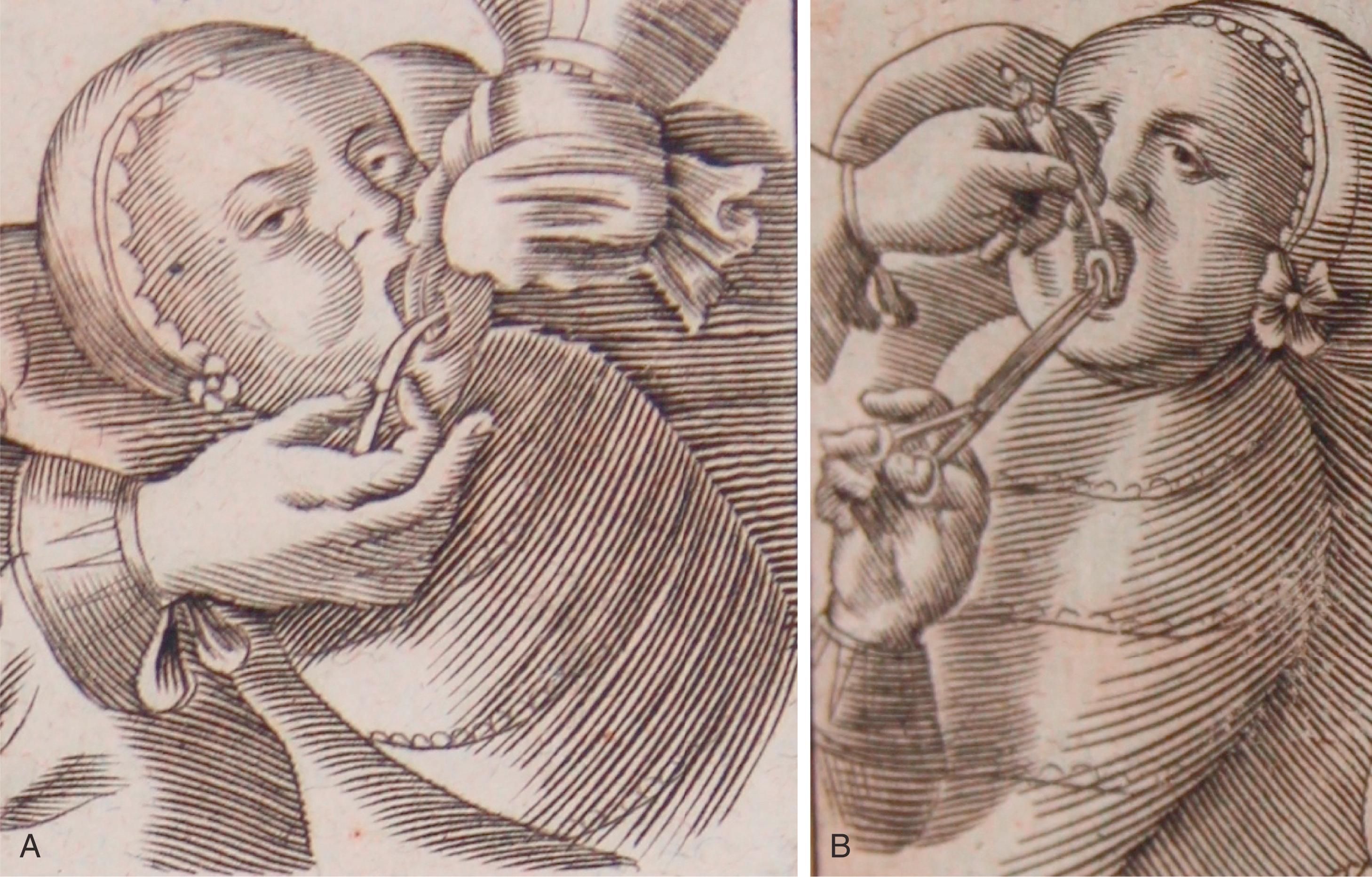
The debate regarding the significance of ankyloglossia and need for surgical intervention has carried into the 20th and 21st centuries. By the early 20th century, strenuous opposition was raised to the practice of frenotomy, and it was all but abandoned. Recently, with the renaissance of breastfeeding, the emphasis has shifted away from speech concerns and toward the facilitation of breastfeeding.
The incidence of ankyloglossia in newborns has been estimated to range from 0.02% to 13.4%. , In a recent study of 302 infants with breastfeeding problems, 171 (57%) were found to have ankyloglossia, with 60% of these having type III ankyloglossia. The lower range of the incidence comes from older studies in which a stricter definition of ankyloglossia was used.
There is little definitive information on the natural history of untreated ankyloglossia. It is important to note that the incidence appears to decrease in older children compared with newborns, suggesting that over time the condition resolves as the frenulum naturally breaks or stretches. This explanation might account for the general perception that this anomaly is more frequently seen in young children than in adults. There are, however, no prospective longitudinal data on the fate of the congenitally short lingual frenulum. This lack of scientific data complicates clinical decision making with regard to the need for treatment and its timing.
Ankyloglossia occurs more commonly in males, with a male-to-female ratio on the order of 1.5:2.6 to 1, with no racial predilection. In a U.S. database study, children with ankyloglossia were more often male (63.6%,), privately insured (60.1%), and from a higher median-income zip code (78.1%).
Most commonly, ankyloglossia is an isolated condition in an otherwise normal individual. Approximately 21% to 50% of individuals with ankyloglossia report a family history of ankyloglossia. , Ankyloglossia can be associated with X-linked cleft palate caused by mutations in the TBX22 gene.
Diagnosis of ankyloglossia is made by observing characteristic physical findings, including the movement of the tongue. The tongue may have a notched or heart-shaped protrusion caused by tethering by the frenulum ( Fig. 33.2 ). Protrusion is limited, and although in some cases the tongue may fail to extend past the lower lip, visualization of the tongue protruding over the lip does not necessarily rule out the presence of ankyloglossia. The tongue may appear to roll or curl with attempted protrusion as the midportion of the tongue moves forward ( Fig. 33.3 ). Affected individuals will characteristically have difficulty lifting or elevating the tip of the tongue toward the upper dentition. Side-to-side motion of the tongue may be impaired as well.
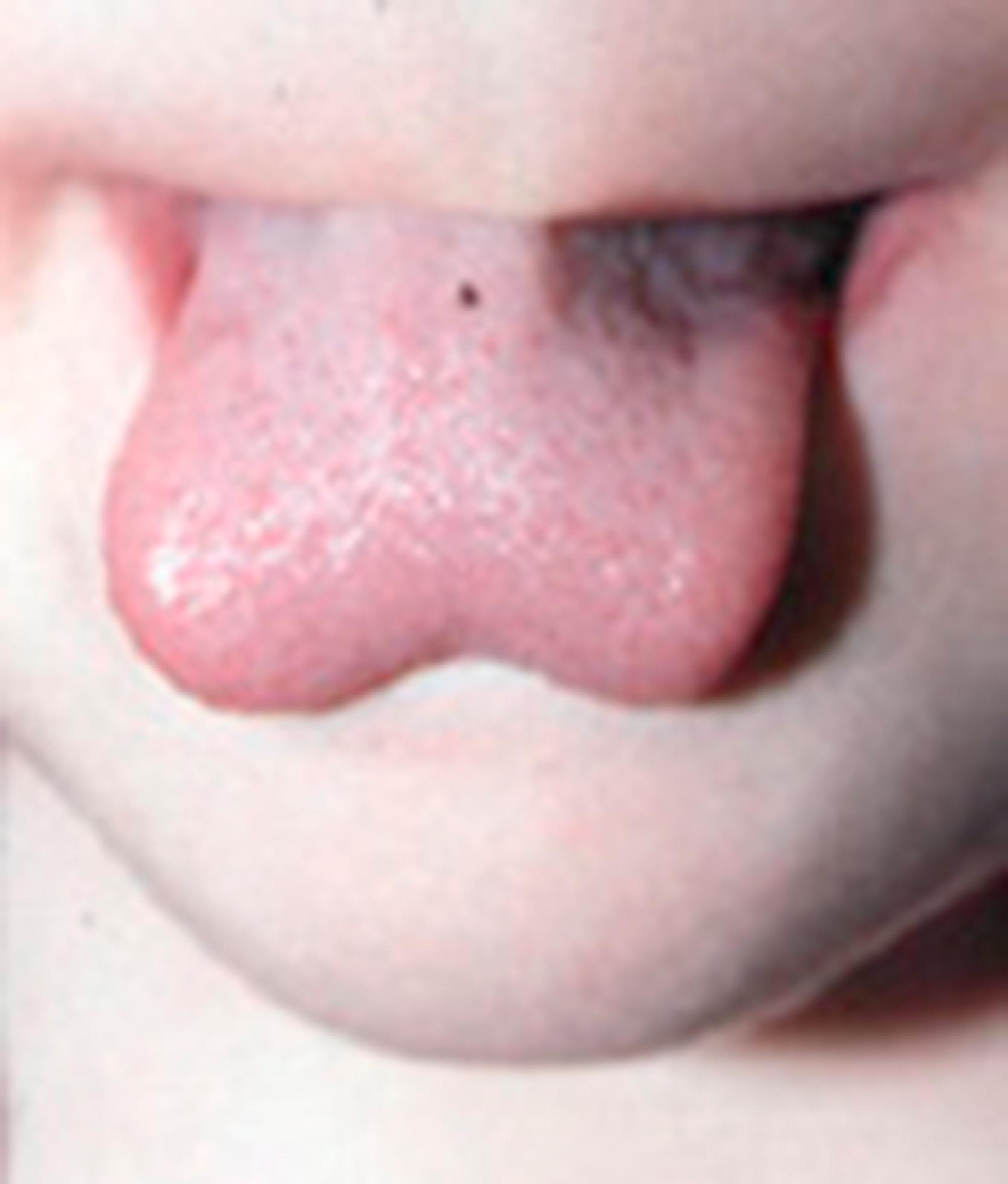
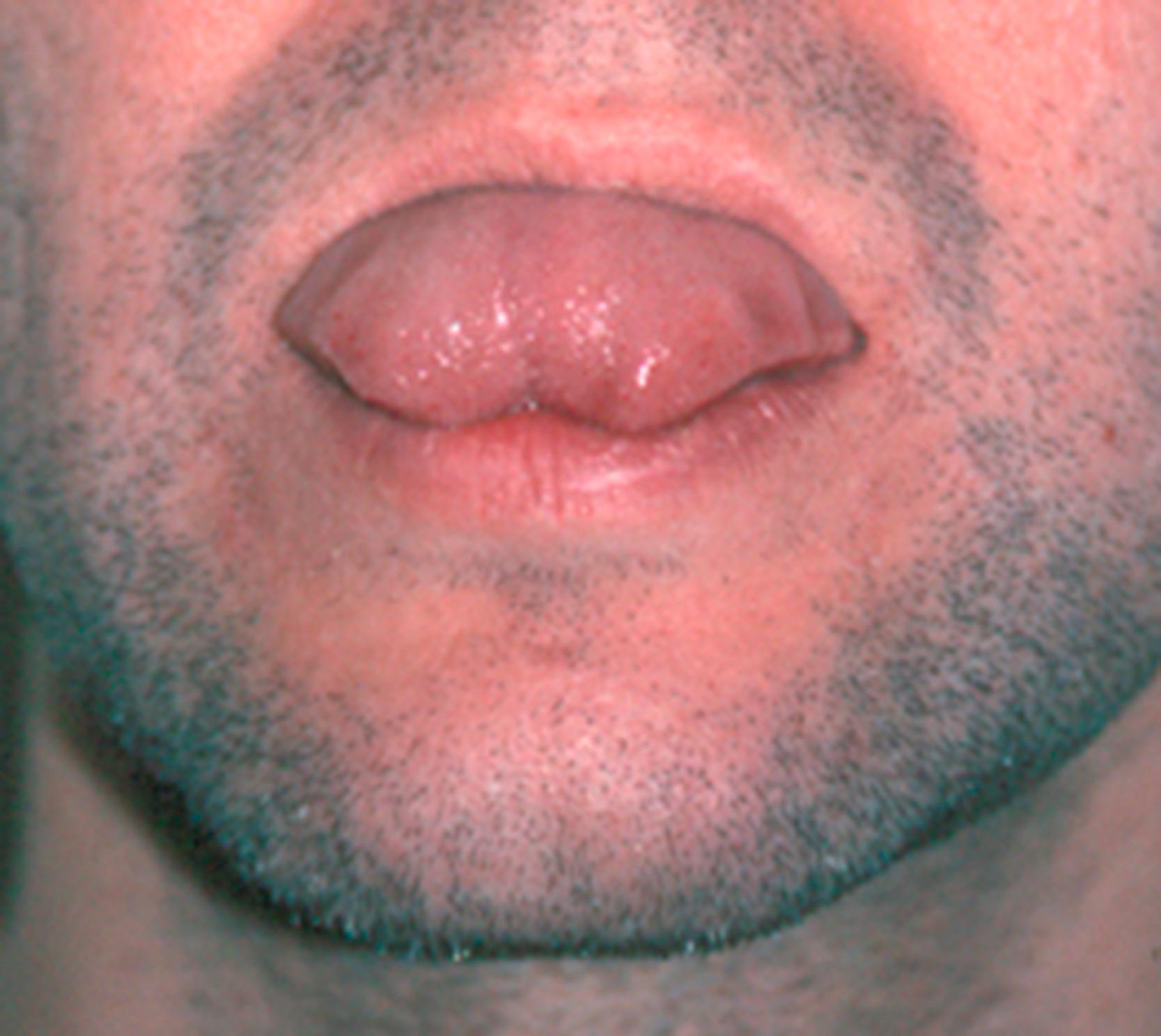
At birth, an infant’s tongue is normally able to extend past the mandibular alveolus. For the infant, multiple assessment tools have been developed to determine the quality of breastfeeding and to help determine what is clinically significant ankyloglossia. The LATCH (latch, audible swallow, nipple type, comfort, help) score is a validated assessment tool used in many hospitals to measure effective breastfeeding and predict breastfeeding duration. The Hazelbaker Assessment Tool for Lingual Frenulum Function (HATLFF) was devised for use in neonates. This tool evaluates seven tongue movements, including lateralization, lift, extension, spread of anterior tongue, cupping, peristalsis, and snap back. Each movement is graded on a scale of 0 to 2e, and if an infant scores poorly, frenotomy is recommended. Although the HATLFF is considered to be comprehensive, it is difficult to use and is not suitable as a screening tool in a busy hospital setting.
The Bristol Tongue Assessment Tool (BTAT) was developed by a group of midwives based on their experience and knowledge of other scoring tools including the HATLFF. It includes (1) tongue tip appearance, (2) attachment of frenulum to lower gum ridge, (3) lift of tongue with mouth wide (crying), and (4) tongue protrusion. Each item is scored (0 to 2) and a low score indicates a more severe reduction of tongue function. The Martinelli Tongue-Tie Tool includes reference pictures of the tongue to assist with a detailed evaluation. The Frenotomy Decision Rule for Breastfeeding Infants was developed to help with the decision for or against frenotomy ( Box 33.1 ).
Mother with nipple pain/trauma while breastfeeding
and/or
inability to maintain latch
and/or
poor weight gain in the infant (<15 g/day),
and a
visible membrane anterior to the base of the tongue, which restricts tongue movement leading to
an inability to touch the roof of the mouth, or
an inability to cup an examining finger, or
an inability to protrude the tongue past the gum line.
In older patients (>3 years), two measurements of tongue mobility may be obtained in the clinic setting to assist with tongue assessment. The first involves measuring the distance from the lower central incisors to the tongue tip when the patient is extending the tongue maximally, and the second evaluates the ability of the tongue to elevate. The patient is asked to touch the tongue tip to the upper teeth and then open the mouth as widely as possible while maintaining contact. While the patient holds this position, the distance between the upper and lower teeth, or interincisal distance, is recorded in millimeters ( Fig. 33.4 ).
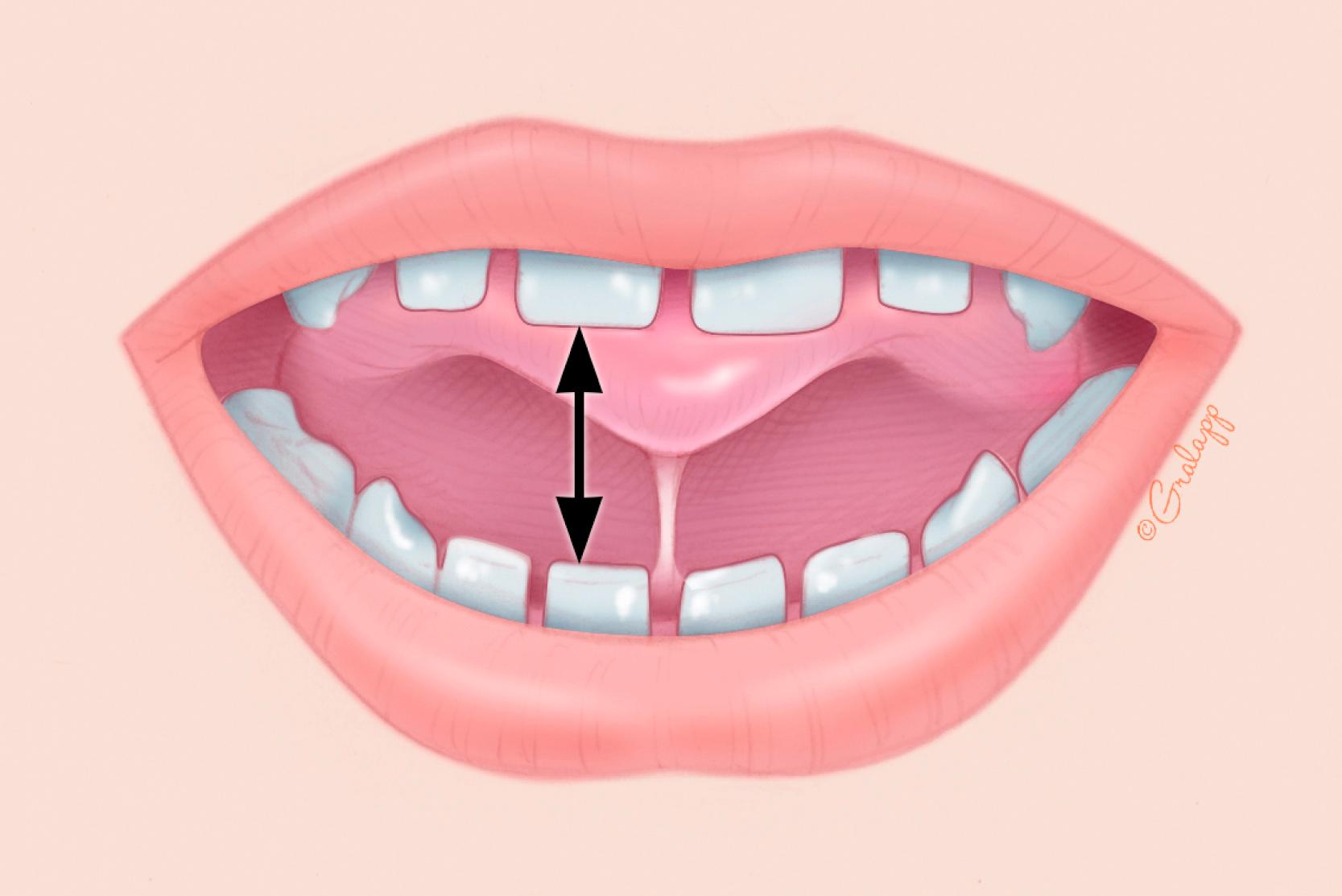
In much of the academic medical literature, ankyloglossia is described as present or not. More recently, there has been an attempt to create a useful classification system for the degree of ankyloglossia. In this system, ankyloglossia is characterized by insertion at the tip of the tongue (type I) or slightly behind the tip (type II), at the mid- to posterior undersurface of the tongue (type III) or a submucosal frenulum (a flat broad mound) that restricts movement at the base of the tongue (type IV) ( Fig. 33.5 ). Types I and II make up the “anterior” or traditional ankyloglossia, and types III and IV are considered “posterior” ankyloglossia. Using these criteria, nearly every newborn can be diagnosed with some type of ankyloglossia, as every infant is born with a frenulum.
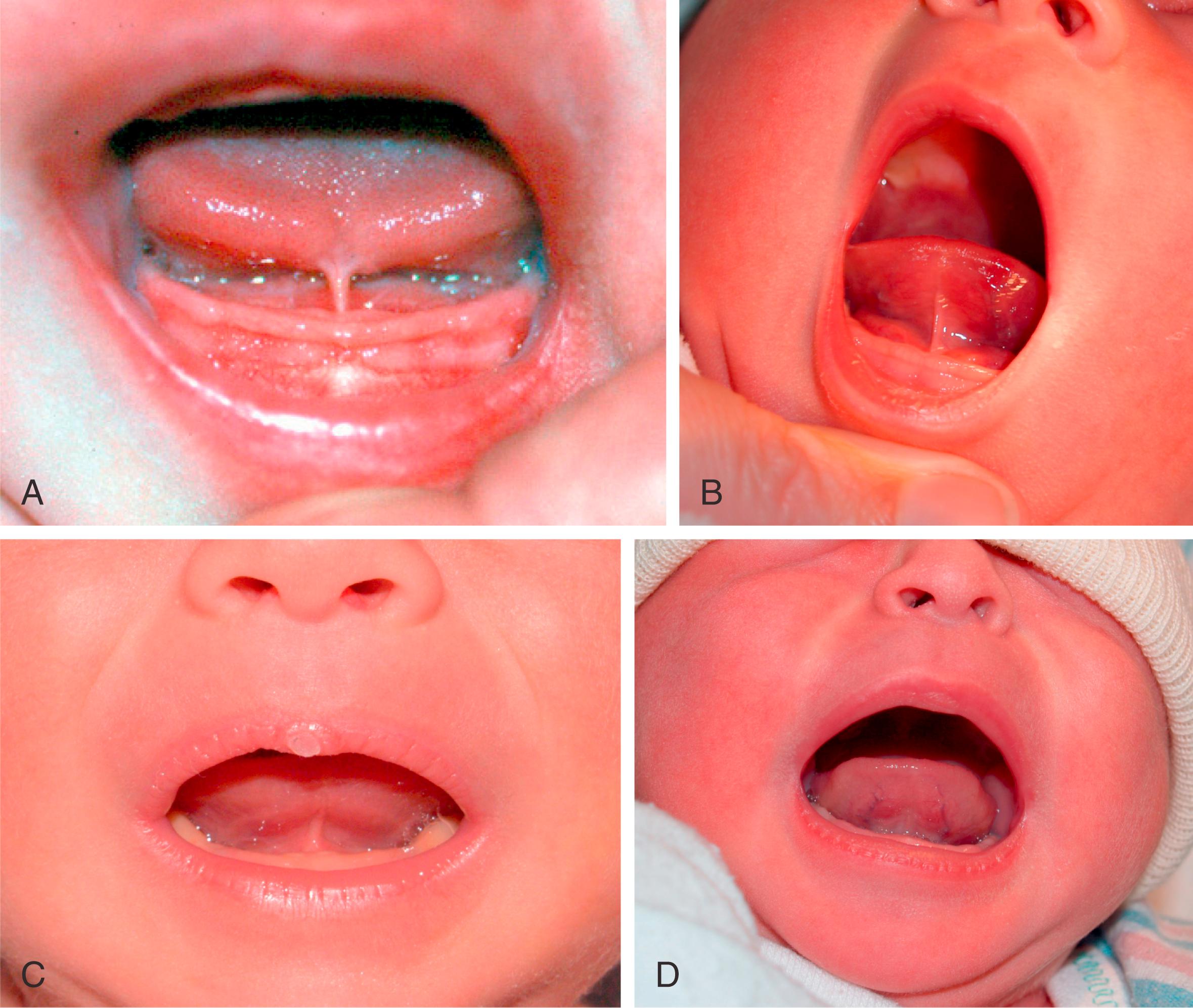
Become a Clinical Tree membership for Full access and enjoy Unlimited articles
If you are a member. Log in here